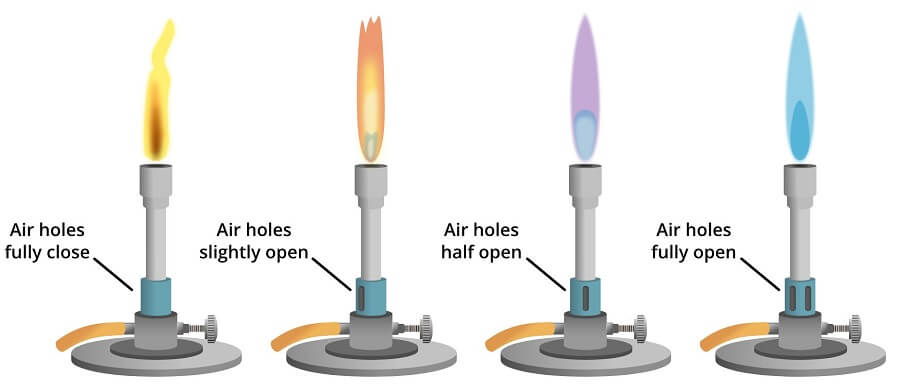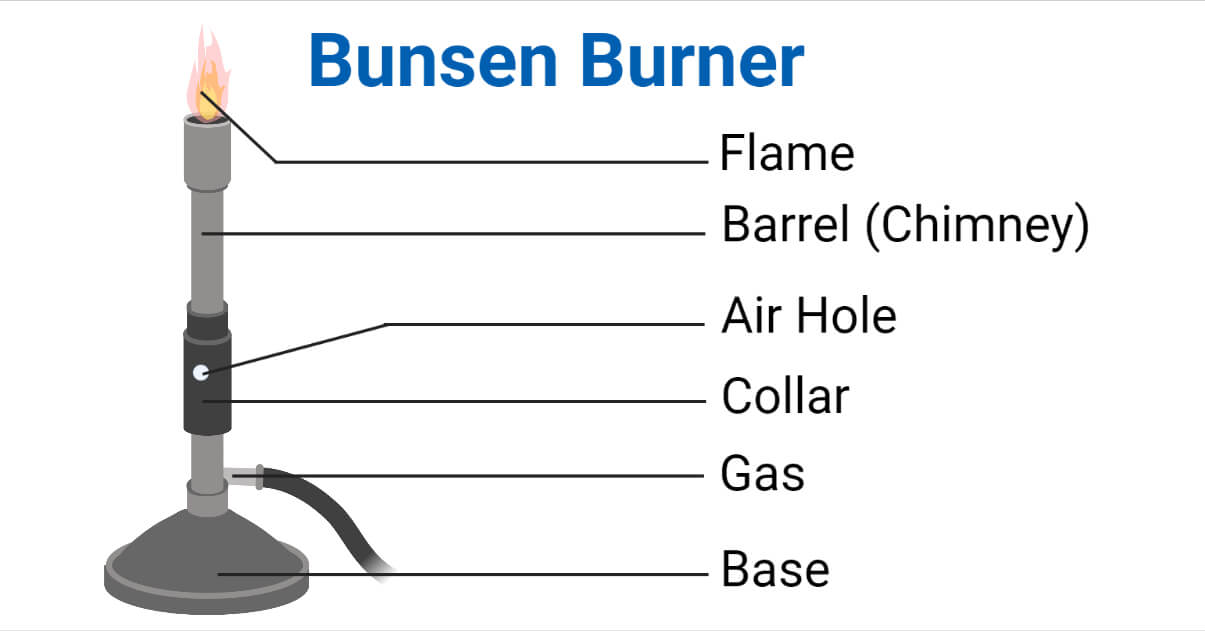Bunsen Burner is a kind of gas burner that creates a safe, smokeless, hot, and non-luminous flame which can be used for various scientific experiments and research.
In 1857, German scientist Robert Bunsen and his lab assistant Peter Desaga invented the Bunsen burner and named it after his surname. It generates a single open gas flame that functions in combustion, sterilization, or heating.
Luminous and non-luminous flame are the two types of flame. When the air-hole is opened, the bright flame will change into a non-luminous flame which can be seen with an orange brilliant flame. The temperature is very moderate.
Additionally, the flame seems unstable and flickering. The non-luminous flame, in contrast, is blue in hue. But one cannot see this flame properly. It is hotter and more stable than the bright flame.
Interesting Science Videos
Bunsen Burner Principle
The burner normally has a metal body and a solid base on the bench. Rubber tubing connects a lab bench’s gas nozzle to the burner’s primary gas inlet at the burner’s base. The ability of the gas (or other fuel) to combine with oxygen before the combination is ignited is crucial to the operation of the burner, i.e., producing an air-gas premix before combustion. This is accomplished by using an air-sucking Venturi-effect inlet valve at the bottom of the burner column when the lab gas nozzle is activated. The diameter of the nozzle is tailored to the type of gas being employed. The vertical tube above the gas entrance has a few tiny holes that allow air to enter the gas mixture from the sides. The gas burns at the top of the burner after being lit with a lighter or match at the top. The bottom-mounted adjustable valve (collar) controls how much oxygen is added to the mixture. Less air supply results in a weaker flame, while more air supply makes the flame stronger. The color of the flame can be used to determine its level of combustion. The air hole or collar can be adjusted to produce flames of various hues.
For instance,
- It emits a yellow flame when the air hole is closed completely (safety fire).
- Upon the air hole being slightly opened, a reddish flame appears (slightly combustion power).
- A purple flame is produced when the air hole is just partially opened (half combustion power).
- A blue flame appears when the air hole is fully opened (strong combustion, hazardous).

Bunsen Burner Parts with their functions
A Bunsen burner is made up of various parts, including:
- Stand or base: The Bunsen burner is supported by the base, a broad and hefty component that comes in various shapes. It’s attached to a side tube known as a gas tube. It helps to place the burner on the bench.
- Barrel or chimney: It is a base-attached vertical metal tube about 5 inches long. It has an air vent near the bottom formed by oppositely positioned holes. The barrel can be fastened to the base with screws. At the nozzle’s higher end, the gas burns after combining with the air from the vent.
- Collar: It joins the base and the barrel. It is a small, cylindrical piece of metal with two holes that are opposite of one another. It regulates how much air enters the barrel.
- Air holes: Air holes in the collar allow air to enter the burner to form a mixture of air and gas or any liquid fuel with air.
- Gas valve: It controls the gas flow.
- Gas intake: It uses a rubber tube to connect to the gas source at the lab bench.

Fuel sources of a Bunsen Burner
The two primary fuel sources for a Bunsen burner are natural gas (mostly methane) and liquefied petroleum gas (propane, butane, or a mixture of the two). A burner for one fuel type should never be used with another type of fuel. So, it’s necessary to make the right choice of the burner depending upon the fuel source.
Types of Bunsen Burner
The three types of Bunsen burner are:
Meker Fisher burner:
The barrel has a wider diameter. Due to the bigger size, there is greater mixing of air and gas. A grid that divides the flame into smaller flames is placed across the top of the barrel. A gas valve situated below the chimney or barrel can be used to regulate the flow of the gas.
Teclu burner
This burner produces more heat effectively. It has a longer barrel tube compared to other burners. Air and gas are thoroughly mixed. As a result, the flame’s combustion power increases. Additionally, the barrel tube has a screw nut for adjusting the gas source.
Tirril burner
At the base of the barrel, it contains a disc valve that can regulate gas flow into the burner.
Types of Bunsen burner flames
Yellow flame
It is referred to as a safety flame since it’s easy to notice in a well-lit space. It can be produced when the air hole is completely closed, and it reaches temperatures of about 300 degrees.
Blue flame
When the air hole is just half opened, it becomes challenging to see in a bright environment. Such flame is known as blue flame, reaching temperatures of 500 degrees.
Roaring blue flame
It is the hottest flame produced when the air hole is completely open, and it can attain temperatures of 700 degrees.
Operating Procedure of Bunsen Burner
- Wear a lab apron and safety glasses. Long hair should be tied back if one has it.
- The rubber tube should be connected to a gas tap.
- When using a Bunsen burner on a surface that is not heat resistant, place a heating pad underneath it.
- A cover for the air hole should be placed on the collar.
- 3 cm above the top of the barrel, light a match and hold it there.
- In the “on” position, turn the gas faucet.
- Extinguish the match when it is lighter.
- Until you need to heat something, leave the flame in “safety mode”.
Applications of Bunsen Burner
- It is used to sterilize loops, needles, and flaming the mouth of test tubes during inoculations, mostly in microbiology laboratories.
- They are used for heat purposes, mostly in chemical laboratories.
- It is used in the dehydration of complexes, drying of salts, moisture analysis, and identification of water of crystallization.
- It helps to determine melting point using classical calorimetry and boiling point using thiele tube method.
- It is used for the flammability of compounds and the flash point of solvents.
Advantages of Bunsen Burner
- It is quite easy to handle.
- It can be utilized anywhere there is access to gas (coal gas, natural gas, etc.).
- The burner is available in various sizes, so we may pick one that works best for us.
- In addition to heating, we can utilize it for basic glass-blowing tasks and air drying.
- The burner may run on low-cost fuels like coal gas and natural gas. It doesn’t require a lot of complicated tools.
- We can obtain flames with a range of temperatures due to the adjustable air inlet.
- A convection current can be produced by the heat of a Bunsen burner flame, which heats the area above the flame and removes any airborne particles from the colder air beneath it, keeping this work area sterile.
Limitations of Bunsen Burner
- Fire risk exists constantly.
- It’s difficult to keep the temperature where you want it to be.
Precautions
This type of equipment is flammable and burns at a very high temperature, potentially resulting in an accident if not handled mindfully. Following are the points to be considered while operating the Bunsen burner are:
- We must work in a space free of extraneous objects such as notebooks, paper, etc.
- Long hair must be tied back, and loose clothing or jewelry should be avoided.
- Always look for cracks, holes, or other flaws in the rubber tubing that could lead to a leak. Any hoses or tubes that are broken should be replaced.
- Use a lighter with an expanded nozzle rather than a match to light a Bunsen burner.
- Before opening the gas faucet, get your lighter ready. If a flame is not in use, it should always remain safe.
- Even with the safety flame on, a Bunsen burner should never be left alone.
- After the experiment is complete, immediately turn off the gas.
- Avoid handling the equipment while it’s still hot, and let it cool down fully after usage.
Examples of Bunsen Burner
A. FIREBOY Safety Bunsen Burner (Manufacturer: Integra Biosciences)
Features
- Monitoring the flame stops gas leaks
- Automatic ignition, requiring neither a lighter nor matches
- Gas cartridge adapters: Independent of any gas delivery system
- Optional battery: no external power source is required.
B. Bunsen acc. to Bunsen (Manufacturer: Marienfeld Superior)
Features
- composed of non-corrosive materials
- nickel-plated air regulation,
- needle valve for gas type selection
- both natural gas and propane can be suitable as a fuel source
C. Laboratory Bunsen burner 4056/B (Manufacturer: Techno Gaz)
Features
- A new universal nozzle makes it possible to use it with any type of gas GPL and at any pressure.
- A valve block and a sensor unit make up the thermocouple. This thermocouple is a safety mechanism that shuts off the gas flow if the flame goes out, preventing potential environmental gas saturation.
D. Bunsen Burner BEC2 series (Manufacturer: Medline Scientific Ltd.)
Features
- An alternative to traditional gas Bunsen burners that is special and safe
- A focused stream of heat equal to that of current gas-powered Bunsen burners is produced by the high-power heater in conjunction with an internally reflective stainless-steel bowl.
- Comes with a wire safety guard, retort stand, and clamps.
- The internal stainless steel bowl is reflective.
References
- https://www.hbarsci.com/blogs/articles/10099273-understanding-products-bunsen-burners
- https://sites.google.com/site/glenscienceeportfolio/reflections/bunsen-burner-and-types-of-flames
- https://edulab.com/the-bunsen-burner-what-is-it-and-how-to-use-it-safely/
- https://www.google.com/amp/s/universe84a.com/bunsen-burner-introduction/%3famp=1
- https://psiberg.com/bunsen-burner/
- https://www.jove.com/v/5035/introduction-to-the-bunsen-burner
- https://dlu.com.ua/FIREBOY-Safety-Bunsen-Burner
- https://www.directindustry.com/prod/medline-scientific-ltd/product-107585-2357621.html
- https://www.marienfeld-superior.com/burners-acc-to-bunsen.html
- https://www.medicalexpo.com/prod/tecno-gaz/product-70281-633645.html
